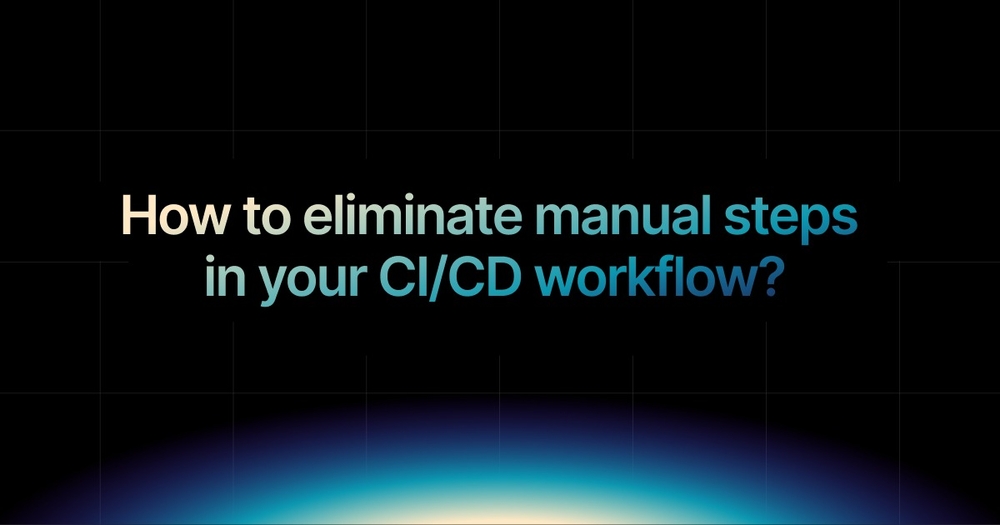Published
- 6 min read
How to eliminate manual steps in your CI/CD workflow?

A robust CI/CD workflow is the backbone of modern software delivery. It promises speed, reliability, and confidence with every commit. But the reality for most teams, especially developers at startups, solo builders, and small engineering organisations, isn’t nearly as seamless.
The tools are there. Jenkins, GitHub Actions, CircleCI, and other CI CD tools offer powerful building blocks. But getting them to work together in a real-world DevOps workflow often feels like stitching together a dozen moving parts: YAML files, shell scripts, deployment logic, Dockerfiles, cloud permissions, monitoring hooks, and rollback mechanisms.
What starts as an attempt to automate CI/CD ends up requiring constant maintenance. Every new service, every environment change, and every bug fix introduces more manual deployment steps. Teams lose momentum to repetitive setup, troubleshooting pipeline errors, and switching between tools to debug issues that shouldn’t exist in the first place.
This isn’t just a tooling issue. It’s a workflow design problem.
Whether you’re a developer, a DevOps engineer, or leading a small team, if you’re looking to simplify your CI/CD setup, reduce failure points, and finally get back to building, this is the place to start.
If you’re still evaluating your current tools, check out this guide to the best CI/CD tools in 2025 to see how the ecosystem is evolving.
CI/CD Pipeline Stages and Phases
 Before we talk about eliminating manual steps, it’s important to understand the structure of a typical CI/CD workflow. Most pipelines follow a predictable sequence, whether you’re using Jenkins, GitHub Actions, or any modern CI CD tool. The workflow spans everything from validating code to getting it live in production.
Before we talk about eliminating manual steps, it’s important to understand the structure of a typical CI/CD workflow. Most pipelines follow a predictable sequence, whether you’re using Jenkins, GitHub Actions, or any modern CI CD tool. The workflow spans everything from validating code to getting it live in production.
Here’s how the phases typically break down:
Trigger
The pipeline begins with a code push or pull request. In some setups, this is automated. In others, it’s still triggered manually.
Build
Source code is compiled, dependencies are installed, and often a Docker image is created. Manual build scripts or Dockerfiles are common here and a common source of drift.
Test
Unit, integration, or end-to-end tests are run in this stage. Many teams still orchestrate tests manually or don’t parallelize, which slows everything down.
Deploy to Staging
The code moves to a pre-production environment. Manual deployment logic, infrastructure configuration, or approvals often get in the way here.
Approval /Manual Gate (Optional)
Some teams include a manual checkpoint before production. While useful in regulated workflows, this step often exists because rollback isn’t easy.
Deploy to Production
Ideally, this should be fully automated. In reality, it’s often a manual deploy process involving scripts, cloud dashboards, or Slack approvals.
These phases are common across most DevOps workflows, but depending on your team size and goals, the right tool can look very different. Here’s a breakdown of how to choose the right CI/CD tool for your team based on workflow complexity and team needs.
Automate CI/CD Process with Kuberns
Most CI/CD tools help you automate parts of the workflow. They run your build, execute tests, maybe push a deploy. However, they still expect you to handle the surrounding complexity: writing Dockerfiles, managing infrastructure, setting up monitoring, and troubleshooting broken rollbacks.
That’s where Kuberns takes a different approach.

Instead of just automating CI/CD stages, it automates the entire deployment workflow from code push to production-ready infrastructure with zero YAML, zero scripts, and zero toolchain sprawl.
Here’s how it works:
- Instant CI/CD Setup. Just connect your GitHub or GitLab repo. Kuberns automatically detects your stack, builds the image, runs tests, and provisions everything needed for deployment.
- No Scripts. No Dockerfiles. You don’t need to write or maintain any custom scripts. Kuberns handles container builds, environment setup, and deployment logic behind the scenes.
- Staging & Production Ready Out of the Box Kuberns gives you pre-configured environments with built-in support for rollbacks, health checks, and logs. No extra cloud setup required.
- Smart Rollbacks & Real-Time Alerts If a deployment fails, Kuberns alerts you immediately and rolls back to a stable version, automatically.
- Lower Infrastructure Costs by Default: Apps run on optimised cloud infrastructure managed by Kuberns. Most teams cut cloud costs by up to 40% without lifting a finger.
In short, Kuberns removes the manual steps CI CD tools typically leave behind. It’s not just about automation, it’s about freeing developers from DevOps overhead so they can focus on building.
If you’re curious how Kuberns compares with other tools focused on fast deployment, check out this list of the top continuous deployment platforms, including how quickly you can get started.
Best Practices to Optimise the CI/CD Process
 Even with automation in place, many teams struggle with slow pipelines, fragile deploys, and too many moving parts.
Even with automation in place, many teams struggle with slow pipelines, fragile deploys, and too many moving parts.
These best practices can help simplify your DevOps workflow and reduce manual effort, especially when paired with a platform built to support them by default.
1. Keep Pipelines Fast and Focused
Avoid long, bloated pipelines. Use caching, parallelism, and run only what’s needed. Traditional tools make you configure this manually. Kuberns optimises these steps out of the box, without requiring YAML tweaks or plugin setup.
2. Automate Beyond Build & Test
Don’t stop at CI. Automate environment creation, infra provisioning, and deployment logic. Most CI/CD tools require additional scripts or services to accomplish this. Kuberns handles it all natively.
3. Standardise Environments
Staging should match production. With most setups, you’re responsible for that consistency. Kuberns uses containerised, pre-configured environments that behave the same across the board—no surprises during deployment.
4. Make Observability Default
Logs, alerts, and health checks shouldn’t be afterthoughts. Kuberns includes integrated observability, so you’re not wiring up separate tools for basic visibility.
5. Fail Fast, Recover Instantly
CI/CD should stop early on failure and recover just as quickly. Kuberns detects bad deploys and rolls back automatically, reducing downtime without needing rollback scripts.
The takeaway? Even the best CI CD tools require effort to follow these best practices. Kuberns removes that burden. It’s designed around these principles from day one, so your team doesn’t have to build them from scratch.
Ready to eliminate the Manual CI/CD work?
CI/CD should help you move faster, not slow you down with scripts, YAML, and constant tool configuration.
If your team is spending more time managing pipelines than shipping features, it’s probably time to rethink your setup.
Kuberns was built to take the manual steps out of your CI/CD workflow. No plugins to wire up. No Dockerfiles to maintain. No fragile rollback logic or scattered dashboards.
Whether you’re working solo or running a growing engineering team, Kuberns helps you ship confidently without worrying about what’s happening behind the scenes.
👉 Deploy your first project with Kuberns in minutes
